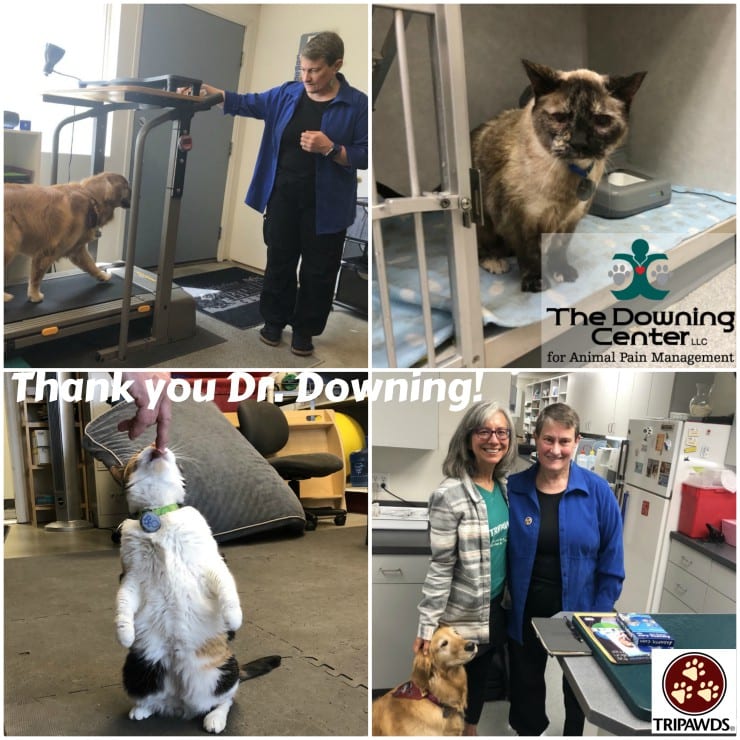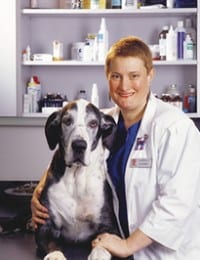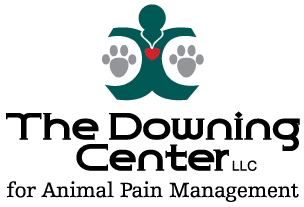Today we are ending Pet Pain Awareness Month in a big way, by discussing Tripawd quality of life tips. Your guide is pet pain management hero, Dr. Robin Downing.

Be sure to catch all seven videos with Dr. Downing!
Video 1: Why we must advocate for our Tripawds
Video 2: How to know if your pet is in pain
Video 3: The truth about phantom leg pain in Tripawds
Video 4: How to Treat Amputation Recovery Pain in Pets
Video 5: Help manage Tripawd phantom pain with Gabapentin
Video 6: Pet pain quality of life tips (see below)
Video 7: How to help a Tripawd age well (see below)
Part 1: Tripawd Quality of Life Tips
Want to know the best way to keep your three-legged cat or dog happy and healthy? It’s not that hard. In this next video, Dr. Downing share details on the three ways to keep your Tripawd healthy:
- Find a vet who understands the biomechanics of an amputee animal
- Keep your Tripawd’s weight down
- Create a Tripawd-friendly home
Watch Dr. Downing share her three best ideas for a healthy, hoppy Tripawd. Then, scroll down for her final helpful tip about using a Quality of Life Scale for Pets.
Transcript:
Tripawd Quality of Life Tips
Tripawds: So what are the three biggest things that we as pet parents can do to keep our Tripawds pain-free with a good quality of life as they get older?
Dr. Downing: Keeping a Tripawd at a high quality of life and comfortable should be everyone’s priority.
First, find a Tripawd-savvy vet.
The most effective strategy for actually accomplishing that is finding a veterinarian who is savvy about chronic pain management and the altered biomechanics that happen with an amputation. The biomechanics of a quadruped change dramatically when one of the four limbs is gone and that altered biomechanics does have an adverse effect on all the rest of the joints in the body.
For instance, when I see an amputee who’s doing very well, it does not deter me from acknowledging that that dog or that cat is going to have alterations in their spine biomechanics for instance.
The facet joints in the spine will function differently and over time, those same facet joints will enjoy a level of deterioration and a kind of deterioration that’s going to happen – that’s different from an animal that gets to walk on four legs all the time.
Working with a veterinarian who is competent to really identify, recognize, acknowledge and then work with altered biomechanics is really important.
Next, keep your Tripawd’s weight down.
Another part of that is keeping that Tripawd lean, lean and mean. Overweight is a huge contributor to just the mechanics of getting around on three legs, a detrimental effect.
But the thing that most consumers don’t remember or realize is that the fat that is accumulated, that makes the pet overweight or obese, actually secretes inflammatory and pro-inflammatory hormones that amplify any pain experience they’re having.
The less fat there is in that fat compartment, the less amplification of a pain experience that animal will have.
Finally, make a Tripawd-friendly home.
We also want to make certain that we do environmental adaptation. So that means unfortunately, as beautiful as hardwood is, not having slick surfaces. They don’t deserve that.
They deserve non-skid surfaces and a veterinarian who is thinking about those details will help the owner of a Tripawd know, hey, you’re going to have to adapt the home environment.
Making sure that we have dishes raised to about elbow level instead of having dishes on the floor. Dishes on the floor, that’s a balancing act that a Tripawd shouldn’t be invited to do.
These are the kinds of things that we as pet owners of Tripawds can do to advocate on behalf of those animals to really focus on quality of life issues.
[End of transcript]
Part 2: How to Measure a Pet’s Quality of Life
The concept of a pet’s “quality of life” is different for each of us. In this next and final video in our Tripawd pain management tips with Dr. Downing, she explains how we can measure a cat or dog’s quality of life with help from Dr. Alice Villalobos’ Quality of Life Scale.
Transcript:
Quality of Life Scale for
Aging Three Legged Dogs and Cats
Dr. Downing: Another aspect of quality of life that I think pet owners of Tripawds need to be aware of is that we now have some quality of life scales that are really useful for people to use.
My favorite remains the one that was created by Dr. Alice Villalobos who’s an oncologist in California who put together a quality of life scale that allows us to objectify a very subjective experience.
Quality of life is pretty subjective. But it helps us by giving us very specific areas to think about.
Hurt: we want to make sure that we are taking care of pain and hunger and hydration and we want to make sure that we have more good days than bad. We want to make sure that we’re taking care of mobility issues and as mobility becomes more challenging, that we made adaptations to that mobility.
So, utilizing a wheelchair, for instance, for a dog or a cat. I’ve had two cats in wheelchairs and they’ve done really well. Utilizing an assistive device like a wheelchair to help them walk.
Utilizing physical therapy, like hydrotherapy. I put cats and dogs in my underwater treadmill to help them build strength by using their limbs, using their muscles in ways they wouldn’t be able to and just the gravity of the air because the water buoys them and helps support them. They can still enjoy a full range of motion. But they don’t have the concussive forces of gravity.
Looking at objectifying that experience of each of those categories as we get closer to the end of life helps us better understand when are we approaching a time when that animal no longer wants to be here with us.
[End of transcript]
Meet Dr. Robin Downing

What an honor to work with Dr. Downing on this important Tripawd Pain Management video series. She an incredibly busy veterinary pain management guru, but still made herself so accessible to us for these interviews. We are furever grateful!
Here’s why we are so thrilled to have Dr. Downing join us:
Dr. Robin Downing, DVM, MS (Bioethics), DAIPM, DACVSMR, CVPP, CCRP, is owner of the AAHA-accredited Windsor Veterinary Clinic in Northern Colorado, a Fear-Free® and Feline-Friendly certified practice for dogs and cats. She is also founder of the Downing Center for Animal Pain Management.
Dr. Downing is also founder and past-president of the International Veterinary Academy of Pain Management, holds multiple credentials in pain management fields like animal chiropractic care, canine medical massage and medical acupuncture for animals.
As a clinical bioethicist, Dr. Downing is also at the forefront of studying the practices, procedures and outcomes of modern medical care decisions and scenarios that pet providers, caregivers and pets confront. She is the first veterinarian to earn a Masters in Bioethics, with the goal of transferring human medical bioethics practices to veterinary practice.
Listen to Dr. Downing on the Veterinary Viewfinder Podcast!


Very helpful information. I did not know that “the fat that is accumulated, that makes the pet overweight or obese, actually secretes inflammatory and pro-inflammatory hormones that amplify any pain experience they’re having. The less fat there is in that fat compartment, the less amplification of a pain experience that animal will have.”
I assumed it was just the stress of bearing extra weight. I’ll keep this in mind for my other rescue cats and dogs who are chubby but always proclaiming they’re “starving”!!!
Carolina, I’m glad you found this helpful. You are such a good pet parent! Yes, the inflammation causes more pain by amplifying it. This is why we are committed to dropping weight on our Nellie so she can feel better on her bad leg.